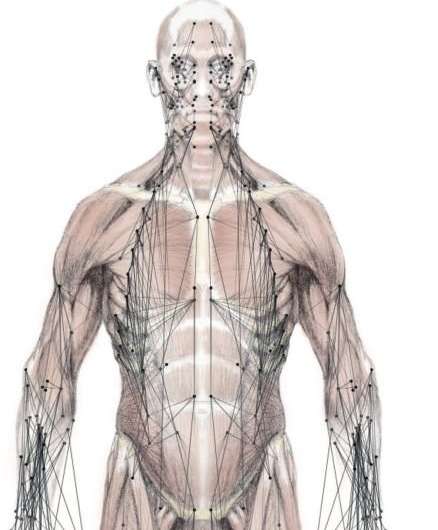Researchers have converted the entire body's network of bones and muscles into a comprehensive mathematical model. Credit: Brittany Bennet
While detailed anatomical studies of the musculoskeletal system have existed since the days of Leonardo da Vinci, new research led by Danielle Bassett at The University of Pennsylvania's School of Engineering and Applied Science is the first to convert the entire body's network of bones and muscles into a comprehensive mathematical model. A study of the network is publishing on January 18 in the open access journal PLOS Biology.
Network science examines how the actions of a system's individual parts affect the behavior of the system as a whole. Some commonly studied networks include computer chip components and social media users, but University of Pennsylvania engineers are now applying network science to a much older system: the human body.
Although the authors' network model simplifies matters by treating bones as "balls" and muscles as "springs," it can nevertheless provide sharper insight into how an injury in one part of the body can lead to increased strain on another.
The authors say that as the model becomes more realistic and tailored to individuals, it could help clinicians and physical therapists predict compensatory injuries and suggest ways of avoiding them.
"People who study biomechanics tend to focus on a single part of the body—the shoulder, the wrist, or the knee," Bassett said. "Because that knowledge is so localized, they don't have a way of connecting it to the rest of the body or to think about compensatory injuries that are far away.
"We actually had to go back to 'Gray's Anatomy' type texts. It was a long, painstaking effort figuring out which bone connects to which muscle and collating that data into a full network."
Even in its highly abstract form, this network provides a picture of how forces are transmitted throughout the musculoskeletal system.
"We can say, 'if this is the muscle you injured, here are the other muscles we should be most worried about,'" Bassett said.
The researchers also compared their network to the "motor homunculus," a way of mapping specific brain regions to the parts of the body they control.
"We saw that the more impact that a muscle has on the rest of the body, the more real estate we use in our brain to control it," Bassett said. "We think it's a way for us to maintain robustness in those muscles—if a muscle can have a massive impact on the rest of the body you don't want any error in controlling it."
Future work will refine the network, adding more realistic masses for individual bones and stretchiness for individual muscles. The modeling of tendons, and muscles that have more complicated flexing behaviors, will also be improved.
More information: Murphy AC, Muldoon SF, Baker D, Lastowka A, Bennett B, Yang M, et al. (2018) Structure, function, and control of the human musculoskeletal network. PLoS Biol 16(1): e2002811. doi.org/10.1371/journal.pbio.2002811
Journal information: PLoS Biology
Provided by Public Library of Science























